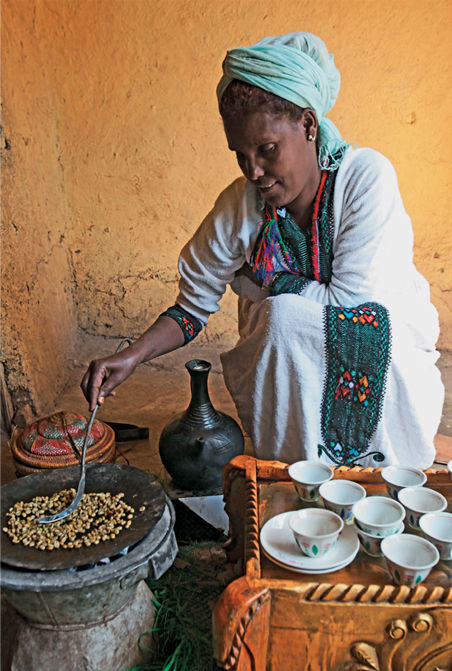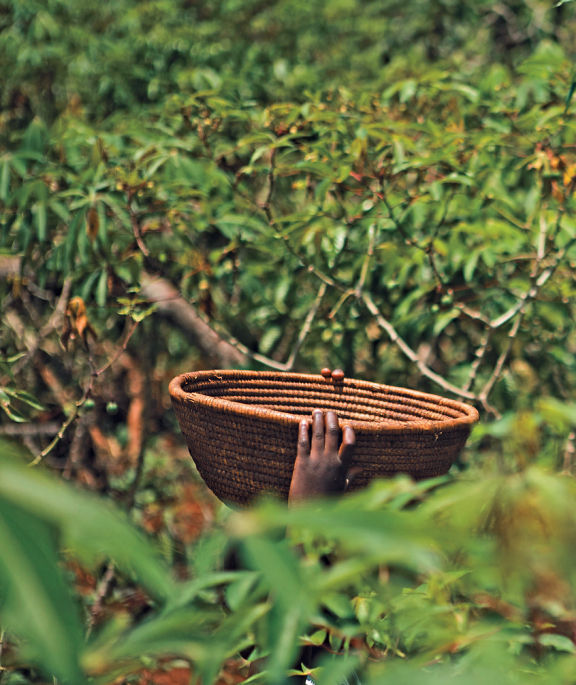Of all the coffee-producing countries, Ethiopia is perhaps the most compelling. Its fascination stems not only from the unusual, astonishing coffees it produces, but from the mystery that shrouds so much of it. The explosively floral and fruity coffees from Ethiopia have opened many a coffee professional’s eyes to the diversity of flavour that coffee can have.

Ethiopia is referred to as the birthplace of coffee, although this should come with some caveats. It is likely Coffea arabica first appeared in southern Sudan, but it only flourished once it spread into Ethiopia. It was here that it was first consumed by humans, initially as a fruit rather than a beverage. Yemen was the first country to grow coffee as a crop, but it had been harvested from the wild in Ethiopia long before.
Coffee was probably first exported from Ethiopia in the 1600s. Interest from European traders was often rebuffed and it then waned as coffee plantations began to appear in Yemen, Java and ultimately the Americas. Coffee production in Ethiopia at the time was essentially the harvest of wild coffee trees that grew in the districts of Kaffa and Buno, rather than from plantations.

ETHIOPIA’S PRODUCTION SYSTEMS
Ethiopia’s coffees can be divided into three main categories, depending on their method of production.
FOREST COFFEES
These come from the wild coffee trees grown mostly in the southwest of the country. These trees usually have a mix of natural shade plants around them, and themselves are a broad mixture of different varieties. The productivity and yield of these trees is low compared to more purposefully cultivated plants.
GARDEN COFFEES
These are coffees from trees typically planted around a homestead or other dwelling. There is less natural shade and more management of the shade trees, such as regular pruning to prevent too much shading. Many producers use some fertilizer on their plants. This type of coffee makes up the bulk of Ethiopia’s production.
PLANTATION COFFEES
These coffees come from trees grown intensively on large farms. Standard agricultural practices are used here, including pruning, mulching, use of fertilizers and the selection of disease-resistant varieties.
Interest returned to Ethiopian coffee in the early 1800s, when there is a record of the export of one hundred quintals of coffee from Enerea, an area of modern-day Ethiopia. In the 19th century, there were two common grades of Ethiopian coffee: Harari (cultivated around the town of Harrar) and Abyssinia (grown in the wild in the rest of the country). For this reason Harrar has a long-standing reputation for being desirable and of high quality (which it does not always earn).
The 1950s were a time of increased structure in the Ethiopian coffee industry and a new grading system was introduced. In 1957 the National Coffee Board of Ethiopia was formed. The overthrow of Emperor Haile Selassie brought change in the 1970s, however. This wasn’t a peasant uprising, more a coup from the elite class tired of famine and conflict. The vacuum of power was filled by the military, which was strongly influenced by socialist ideals. ntil that point the country had been close, in some ways, to a feudal system of government. Among the new ideals was the redistribution of land, and the government quickly began to nationalize it. Some argue that this move was hugely beneficial to the population, increasing the earnings of the rural poor by up to fifty per cent. Strict Marxist rules prevented land ownership or hired labour, and this had a huge impact on the coffee industry. Large-scale farming was abandoned and Ethiopia went back to harvesting its coffee from the wild. The 1980s was a decade of famine, affecting eight million people and killing one million of them.
 Ethiopia is commonly accepted as the birthplace of coffee. This Ethiopian woman performs an age-old coffee ceremony in Wollo, Lalibella.
Ethiopia is commonly accepted as the birthplace of coffee. This Ethiopian woman performs an age-old coffee ceremony in Wollo, Lalibella.
THE MOVE TOWARDS DEMOCRACY
In 1991 the Ethiopian Peoples’ Revolutionary Democratic Front overthrew the Military Junta. This began a process of liberalization and moved the country towards democracy. International markets opened up for Ethiopia, but with them came the effects of fluctuating market prices. Coffee farmers in Ethiopia in particular have had to cope with large, uncontrollable price swings. This has given rise to the formation of cooperatives, offering support to their members, such as funding, market information and transport.
 Coffee beans are hand-graded by women at a factory in Ethiopia. The range of flavours found in Ethiopian coffee beans is broad, owing to the variable climates of different growing regions.
Coffee beans are hand-graded by women at a factory in Ethiopia. The range of flavours found in Ethiopian coffee beans is broad, owing to the variable climates of different growing regions.
THE ETHIOPIAN COMMODITY EXCHANGE
The largest change to the trade of Ethiopian coffee in recent years, and one of great concern to speciality coffee buyers, was the introduction of the Ethiopian Commodity Exchange (ECX) in 2008. The ECX was created for various different commodities in Ethiopia with the aim of creating an efficient trading system that protected both sellers and buyers alike. However, the system frustrated those who wished to buy a distinct, traceable product rather than a commoditized one. Coffees were delivered to the ECX warehouse where they were allocated a numerical denomination of regional origin for washed coffees (from 1–10). All natural-process coffees were marked 11. The coffees were then graded for quality and assigned a number from 1–9, or labelled UG for ungraded.
This process stripped the coffee of its exact traceability before auction, but on the positive side farmers did receive payment for their coffee sooner than they had before. The system also restricted which coffees could be offered on the international market and increased the financial transparency in contracts.
Today there are increasing opportunities to work outside the constraints of the ECX model, and more and more high-quality and traceable coffees are reaching consumers abroad.
TRACEABILITY
It is possible to find Ethiopian coffees from a single estate, though they are relatively rare. Traceability is more likely to lead back to a specific cooperative. However, a coffee roaster may simply have bought a coffee that had come through the ECX and it could still be astonishing despite its lack of transparency. These coffees have so much to offer, so I would recommend finding a roaster whose coffees you already enjoy and asking them for guidance on what is excellent.

Once difficult to trace, the quality and provenance of coffee is becoming more accessible. This allows consumers to make informed choices about where and how their coffee is harvested.
TASTE PROFILE
The flavours of Ethiopian coffees are notably diverse – from citrus, often bergamot, and florals through to candied fruit or even tropical fruit flavours. The best washed coffees can be incredibly elegant, complex and delicious and the best naturally processed ones can be wildly fruity, and enchantingly unusual.
GROWING REGIONS
Population: 102,374,000
Number of 60kg (132lb) bags in 2013: 6,600,000
The growing regions of Ethiopia are among the most recognizable names in coffee, and are used to sell the coffee today and probably will be in the foreseeable future. The genetic potential of the indigenous and wild varieties of Arabica make the future of coffee in Ethiopia an exciting one, too.
SIDAMA
Sidama is one of the three regions (along with Harrar and Yirgacheffe) that the Ethiopian government trademarked in 2004 to bring wider recognition to their distinctive coffees. It produces a mixture of washed and naturally processed coffees that are incredibly popular among those who enjoy a fruity and intensely aromatic cup.
The region was named after the Sidama people, but it is often referred to in coffee as Sidamo. In recent years, there has been some movement to reject the name Sidamo, as it is felt to be derogatory. However, it is something of a brand and deeply embedded in the industry. For this reason, both Sidamo and Sidama are used to describe coffees from the region. This region grows some of the highest coffee in Ethiopia.
| Altitude: | 1,400–2,200m (4,600–7,200ft) |
| Harvest: | October–January |
| Varieties: | Heirloom varieties |
LIMU While it does not have the same reputation as Sidama and Yirgacheffe, Limu still produces some astonishing coffee. This region’s producers are mostly smallholders, but there are some large government-owned plantations in the area.
| Altitude: | 1,400–2,200m (4,600–7,200ft) |
| Harvest: | November–January |
| Varieties: | Heirloom varieties |
JIMA
This region, in the southwest, produces a large portion of Ethiopia’s coffee. Coffees from this region have recently been a little eclipsed by those from other parts of the country but they are definitely worth investigating. The name of this region can also be written as ‘Jimmah’, ‘Jimma’ or ‘Djimmah’.
| Altitude: | 1,400–2,000m (4,600–6,600ft) |
| Harvest: | November–January |
| Varieties: | Heirloom varieties |
GHIMBI/LEKEMPTI
The regions surrounding the two towns of Ghimbi and Lekempti are often combined into one, and a roaster may use one name or the other, or sometimes both. Lekempti is the capital city, but a coffee that is described by this name could actually come from Ghimbi over 100km (62 miles) away.
| Altitude: | 1,500–2,100m (4,900–6,900ft) |
| Harvest: | February–April |
| Varieties: | Heirloom varieties |
HARRAR
This is one of the oldest producing regions, surrounding the small town of Harrar. Coffees from this region are quite distinctly different, and are often grown in environments requiring extra irrigation. Harrar has maintained a strong reputation for many years, although the naturally processed coffees can veer between an unclean, woody earthiness to a more explicit blueberry fruit flavour. The coffees are often so unusual that they are remembered fondly by those who work in the industry as the coffees that opened their eyes to the diversity of flavours possible within a cup.
| Altitude: | 1,500–2,100m (4,900–6,900ft) |
| Harvest: | October–February |
| Varieties: | Heirloom varieties |
YIRGACHEFFE
The coffees from this region are, in many ways, truly unique. So many of the great washed coffees from Yirgacheffe are explosively aromatic, full of citrus and floral notes and have a light and elegant body, so this is undeniably one of the greatest and most interesting regions for growing coffee. The best coffees from this region fetch rightfully high premiums, and while they can remind some people more of a cup of Earl Grey tea than of a cup of coffee, they are absolutely worth seeking out. There are naturally processed coffees produced in this region too, which can also be exceptionally interesting and enjoyable.
| Altitude: | 1,750–2,200m (5,750–7,200ft) |
| Harvest: | October–January |
| Varieties: | Heirloom varieties |